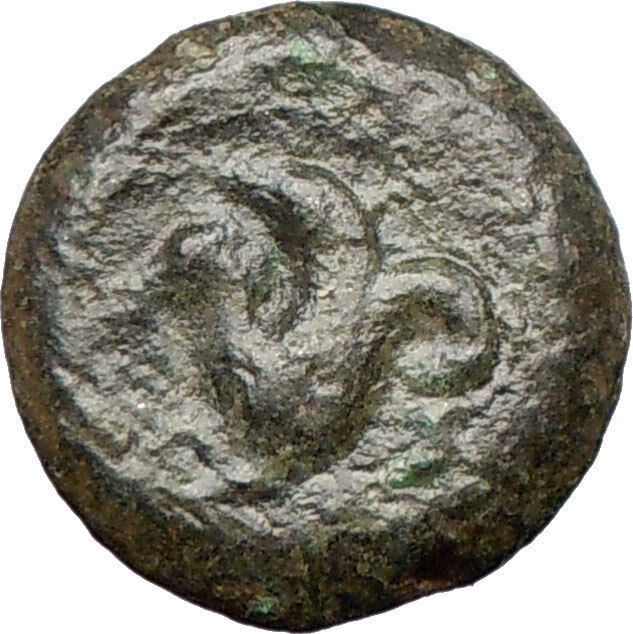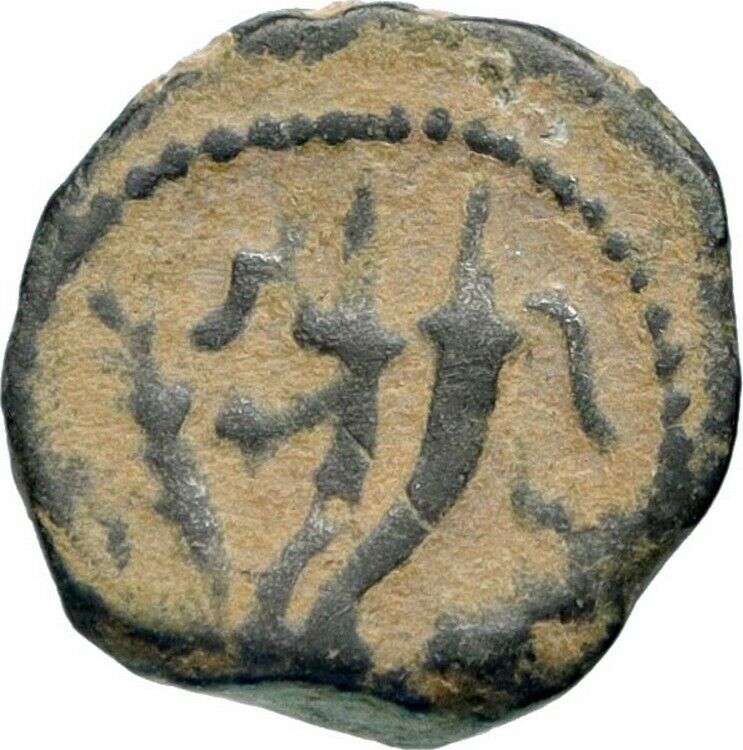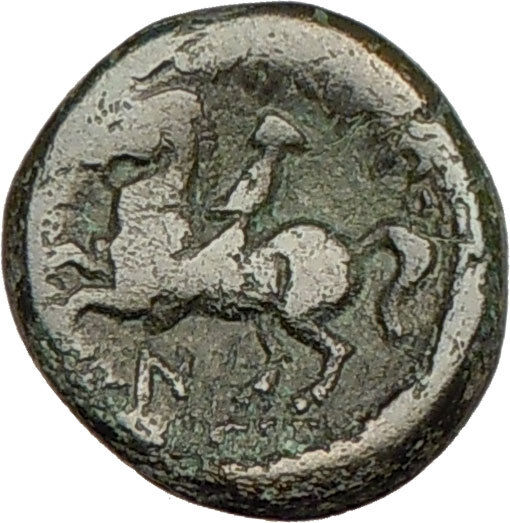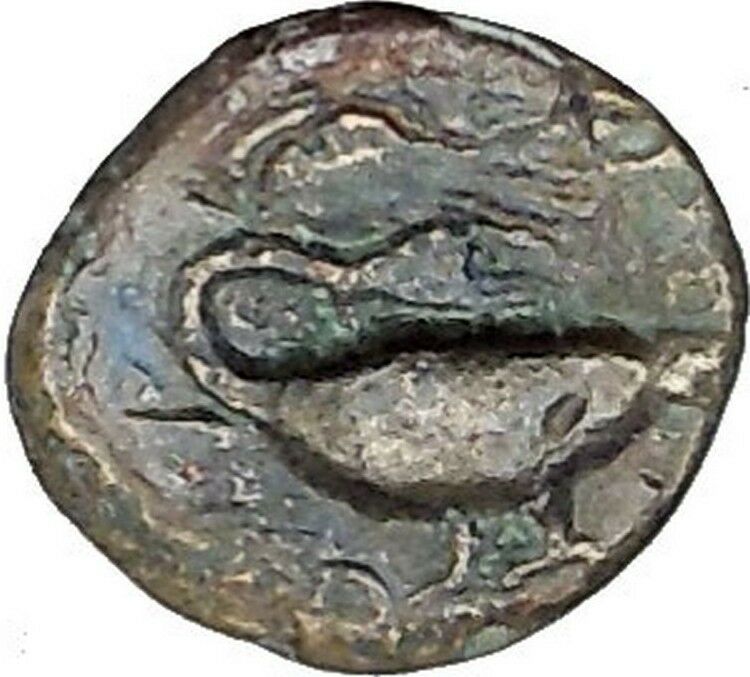|
Greek city of
Lampsakos
in
Mysia
Bronze 14mm (2.52 grams) Struck circa 400-300 B.C.
Reference: Sear 3902 var.
Janiform female head.
ΛΑΜ, Head of
Athena
right, wearing crested helmet.
You are bidding on the exact item pictured,
provided with a Certificate of Authenticity and Lifetime Guarantee of
Authenticity.
In Roman mythology,
Janus is the god of gates,
doors, doorways, beginnings, endings and time. Most often he is depicted as
having two heads, facing opposite directions; one head looks back at the last
year while the other looks forward to the new, simultaneously into the future
and the past.
Janus was usually depicted with two heads facing in opposite directions.
According to a legend, he had received the gift to see both future and past from
the god
Saturn
in reward for the hospitality received.
Janus-like heads of gods related to
Hermes
have been found in Greece, perhaps
suggesting a compound god.
The Romans associated Janus with the
Etruscan deity
Ani
. Several scholars suggest that he was
likely the most important god in the Roman archaic pantheon. He was often
invoked together with Iuppiter (Jupiter).
According to
Macrobius
and
Cicero
, Janus and Jana (Diana)
are a pair of divinities, worshipped as the
sun
and
moon
, whence they were regarded as the highest
of the gods, and received their sacrifices before all the others.
In general, Janus was the patron of concrete and abstract beginnings of the
world (such as the religion and the gods themselves), the human life, new
historical ages, and economical enterprises. He was also the god of the home
entrance (ianua), gates, bridges and covered and arcaded passages (iani)
named after him.
He was frequently used to symbolize change and transitions such as the
progression of past to future, of one condition to another, of one vision to
another, the growing up of young people, and of one universe to another. He was
also known as the figure representing time because he could see into the past
with one face and into the future with the other. Hence, Janus was worshipped at
the beginnings of the harvest and planting times, as well as marriages, deaths
and other beginnings. He was representative of the middle ground between
barbarity and civilization, rural country and urban cities, and youth and
adulthood.
Numa
in his regulation of the
Roman calendar
called the first month
Januarius
after Janus, at the time the
highest divinity. Numa also introduced the
Ianus geminus
(also Janus Bifrons,
Janus Quirinus or Portae Belli) , a passage ritually opened at
times of war, and shut again when Roman arms rested. It formed a walled
enclosure with gates at each end, situated in the
Roman Forum
which had been consecrated by
Numa Pompilius
. In the course of wars, the
gates of the Janus were opened, and in its interior sacrifices and vaticinia
were held to forecast the outcome of military deeds. The doors were closed only
during peacetime, an extremely rare event.
Livy wrote in his
Ab urbe condita
that the doors of the
temple had only been closed twice since the reign of Numa: firstly in 235 BC
after the
first Punic war
and secondly in after the
battle of Actium
in 31 BC. A temple of Janus is
said to have been consecrated by the consul
Gaius Duilius
in 260 BCE after the
Battle of Mylae
in the Forum Holitorium. The
four-side structure known as the
Arch of Janus
in the
Forum Boarium
dates to the 4th century CE.
In the Middle Ages, Janus was also taken as the symbol of
Genoa
, whose Latin name was Ianua, as
well as of other European communes.
In
Greek religion
and
mythology
, Athena or Athene, also
referred to as Pallas Athena/Athene , is the goddess of wisdom, courage,
inspiration, civilization, law and justice, just warfare, mathematics, strength,
strategy, the arts, crafts, and skill.
Minerva
is the
Roman goddess
identified with
Athena.
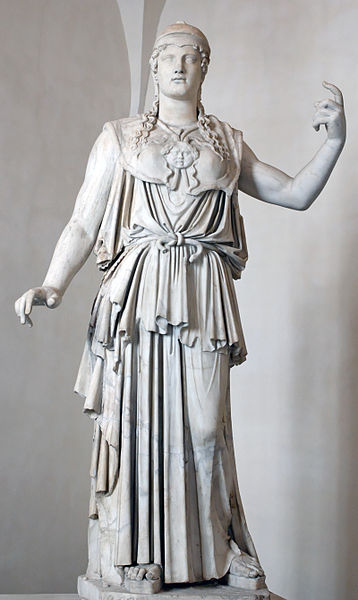
Athena is also a shrewd companion of
heroes and is the
goddess
of heroic endeavour. She is the
virgin
patroness of
Athens
. The Athenians founded the
Parthenon
on the Acropolis of her namesake
city, Athens (Athena Parthenos), in her honour.
Athena’s veneration as the patron of Athens seems to have existed from the
earliest times, and was so persistent that archaic myths about her were recast
to adapt to cultural changes. In her role as a protector of the city (polis),
many people throughout the Greek world worshiped Athena as Athena Polias
(Ἀθηνᾶ Πολιάς “Athena of the city”). The city of
Athens
and the goddess Athena essentially bear
the same name, “Athenai” meaning “[many] Athenas”.
Patroness
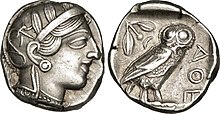
Athenian
tetradrachm
representing the
goddess Athena
Athena as the goddess of philosophy became an aspect of the cult in Classical
Greece during the late 5th century B.C. She is the patroness of various crafts,
especially of weaving
, as Athena Ergane, and was
honored as such at festivals such as
Chalceia
. The metalwork of weapons also fell
under her patronage. She led battles (Athena
Promachos or the warrior maiden Athena Parthenos) as the
disciplined, strategic side of war, in contrast to her brother
Ares, the patron of violence, bloodlust and slaughter—”the raw force
of war”. Athena’s wisdom includes the cunning intelligence (metis) of
such figures as Odysseus
. Not only was this version of Athena
the opposite of Ares in combat, it was also the polar opposite of the serene
earth goddess version of the deity, Athena Polias.
Athena appears in Greek mythology as the patron and helper of many heroes,
including Odysseus
,
Jason
, and
Heracles
. In
Classical Greek
myths, she never consorts with
a lover, nor does she ever marry,earning the title Athena Parthenos. A
remnant of archaic myth depicts her as the adoptive mother of
Erechtheus
/Erichthonius
through the foiled rape by
Hephaestus
. Other variants relate that
Erichthonius, the serpent that accompanied Athena, was born to
Gaia
: when the rape failed, the semen landed on
Gaia and impregnated her. After Erechthonius was born, Gaia gave him to Athena.
Though Athena is a goddess of war strategy, she disliked fighting without
purpose and preferred to use wisdom to settle predicaments.The goddess only
encouraged fighting for a reasonable cause or to resolve conflict. As patron of
Athens she fought in the Trojan war on the side of the Achaeans.
Mythology
Lady of Athens
Athena competed with
Poseidon
to be the patron deity of Athens,
which was yet unnamed, in a version of one
founding myth
. They agreed that each would give
the Athenians one gift and that the Athenians would choose the gift they
preferred. Poseidon struck the ground with his
trident
and a salt water spring sprang up; this
gave them a means of trade and water—Athens at its height was a significant sea
power, defeating the
Persian
fleet at the
Battle of Salamis
—but the water was salty and
not very good for drinking.
Athena, however, offered them the first domesticated
olive tree
. The Athenians (or their king,
Cecrops
) accepted the olive tree and with it
the patronage of Athena, for the olive tree brought wood, oil, and food.
Robert Graves
was of the opinion that
“Poseidon’s attempts to take possession of certain cities are political myths”
which reflect the conflict between matriarchal and patriarchal religions.
Other sites of cult
Athena also was the patron goddess of several other Greek cities, notably
Sparta, where the archaic cult of
Athena Alea
had its sanctuaries in the
surrounding villages of
Mantineia
and, notably,
Tegea
. In Sparta itself, the temple of Athena
Khalkíoikos (Athena “of the Brazen House”, often
latinized
as Chalcioecus) was the
grandest and located on the Spartan acropolis; presumably it had a roof of
bronze. The forecourt of the Brazen House was the place where the most solemn
religious functions in Sparta took place.
Tegea was an important religious center of ancient Greece, containing the
Temple of Athena Alea
. The temenos was founded by
Aleus
,
Pausanias
was informed. Votive bronzes at the
site from the Geometric and Archaic periods take the forms of horses and deer;
there are
sealstone
and
fibulae
. In the Archaic period the nine
villages that underlie Tegea banded together in a
synoecism
to form one city. Tegea was listed in
Homer
‘s
Catalogue of Ships
as one of the cities that
contributed ships and men for the
Achaean assault on Troy
.
Judgment of Paris

Aphrodite is being surveyed by Paris, while Athena (the leftmost
figure) and Hera stand nearby.
El Juicio de Paris
by
Enrique Simonet
, ca. 1904
All the gods and goddesses as well as various mortals were invited to the
marriage of Peleus
and
Thetis
(the eventual parents of
Achilles
). Only
Eris
, goddess of discord, was not invited. She
was annoyed at this, so she arrived with a golden apple inscribed with the word
καλλίστῃ (kallistēi, “for the fairest”), which she threw among the goddesses.
Aphrodite, Hera, and Athena all claimed to be the fairest, and thus the rightful
owner of the apple.
The goddesses chose to place the matter before Zeus, who, not wanting to
favor one of the goddesses, put the choice into the hands of Paris, a
Trojan prince. After bathing in the spring of
Mount Ida
(where Troy was situated), the
goddesses appeared before Paris. The goddesses undressed and presented
themselves to Paris naked, either at his request or for the sake of winning.

Paris is awarding the apple to Aphrodite, while Athena makes a face.
Urteil des Paris by
Anton Raphael Mengs
, ca. 1757
Still, Paris could not decide, as all three were ideally beautiful, so they
resorted to bribes. Hera tried to bribe Paris with control over all
Asia and Europe
, while Athena offered wisdom, fame and
glory in battle, but Aphrodite came forth and whispered to Paris that if he were
to choose her as the fairest he would have the most beautiful mortal woman in
the world as a wife, and he accordingly chose her. This woman was
Helen
, who was, unfortunately for Paris,
already married to King
Menelaus
of
Sparta
. The other two goddesses were enraged by
this and through Helen’s abduction by Paris they brought about the
Trojan War
.

The Parthenon
, Temple of Athena
Parthenos
Masculinity and
feminism
Athena had an “androgynous compromise” that allowed her traits and what she
stood for to be attributed to male and female rulers alike over the course of
history (such as Marie de’ Medici, Anne of Austria, Christina of Sweden, and
Catherine the Great)
J.J. Bachofen advocated that Athena was originally a maternal figure stable
in her security and poise but was caught up and perverted by a patriarchal
society; this was especially the case in Athens. The goddess adapted but could
very easily be seen as a god. He viewed it as “motherless paternity in the place
of fatherless maternity” where once altered, Athena’s character was to be
crystallized as that of a patriarch.
Whereas Bachofen saw the switch to paternity on Athena’s behalf as an
increase of power, Freud on the contrary perceived Athena as an “original mother
goddess divested of her power”. In this interpretation, Athena was demoted to be
only Zeus’s daughter, never allowed the expression of motherhood. Still more
different from Bachofen’s perspective is the lack of role permanency in Freud’s
view: Freud held that time and differing cultures would mold Athena to stand for
what was necessary to them.
Lampsacus ((Greek:
Λάμψακος, Lampsakos, modern:Lapseki)
was an ancient Greek
city strategically located on the eastern side of the
Hellespont
in the northern Troad
.
An inhabitant of Lampsacus was called a Lampsacene. The name has been
transmitted in the nearby modern town of
Lapseki
.
//
History
Originally known as Pityusa or Pityussa
(Greek:
Πιτυουσα, Pituousa, or Πιτυουσσα,
Pituoussa), it was colonized from
Phocaea
and
Miletus
.
During the
6th
and 5th century BC
, Lampsacus was successively dominated by
Lydia
,
Persia
, Athens
,
and Sparta
;
Artaxerxes I
assigned it to
Themistocles
with the expectation that the city supply the Persian king with
its famous wine
.
Lampsacus joined the
Delian League
after the
battle of Mycale
, and paid a tribute of twelve
talents
, a testimony to its wealth, and it had a
gold coinage in the
4th
century BC
, an activity only available to the more prosperous cities.
A revolt against the Athenians in
411 BC
was put
down by force. In 196 BC
, the
Romans
defended the town against
Antiochus the Great
, and it became an ally of Rome;
Cicero
(2
Verr. i. 24. 63) and
Strabo
(13. 1.
15) attest its continuing prosperity under Roman rule. Lampsacus was also
notable for its worship of
Priapus
, who
was said to have been born there.
Lampsacus produced a series of notable philosophers.
Metrodorus of Lampsacus (the elder)
(5th century BC) was a philosopher from
the school of
Anaxagoras
.
Strato of Lampsacus
(c. 335-c. 269 BC) was a Peripatetic philosopher and the
third director of Aristotle’s
Lyceum
at
Athens.
Euaeon of Lampsacus
was one of
Plato
‘s students.
A group of Lampsacenes were in the circle of
Epicurus
;
they included
Polyaenus of Lampsacus
(c. 340 – 278 BC) a mathematician, the philosophers
Idomeneus of Lampsacus
,
Colotes
the
satirist and
Leonteus of Lampsacus
;
Batis of Lampsacus
the wife of Idomeneus, was the sister of
Metrodorus of Lampsacus (the younger)
, whose elder brother, also a friend of
Epicurus, was
Timocrates of Lampsacus
.
Christian
history
According to legend,
St Tryphon
was buried at Lampsacus after his martyrdom at
Nicaea
in 250 AD
.
The first known bishop
in Lampsacus was
Parthenius
, under
Constantine I
. In 364, the
see
was occupied by Marcian
and in the same year a council of bishops was held at Lampsacus.
Marcian, was summoned to the
First Council of Constantinople
of
Constantinople
in 381, but refused to retract his adherence of the
Macedonian
Christian
sect. Other known
Bishops of Lampsacus were
Daniel
, who assisted at the
Council of Chalcedon
(451);
Harmonius
(458); Constantine (680), who attended the
Third Council of Constantinople
; John (787), at Nicaea;
St. Euschemon
, a correspondent of
St. Theodore the Studite
, and a confessor of the Faith for the veneration of
images, under
Theophilus
.
The See of Lampsacus is mentioned in the “Notitiae
Episcopatuum” until about the twelfth or thirteenth century.
Modern
settlement
The nearby settlement of
Lapseki
has
inherited the name; its population is now in the region of 11,000.
|









